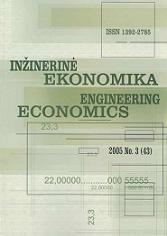Export Pricing in Business-to-business Market
Export Pricing in Business-to-business Market
Author(s): Asta Valuckaitė, Vytautas SnieškaSubject(s): Economy
Published by: Kauno Technologijos Universitetas
Keywords: export pricing; pricing in business-to-business market; export pricing distinguishing features.
Summary/Abstract: The importance of pricing as a profit driver led to development of strategies and methods to improve pricing. Although pricing in business-to-business (B2B) and retail markets has the same goals, but the challenges of them are different. Export pricing and its distinguishing features from retail point: the consumer is a firm, business-to business purchases are made by decision making unit, purchase decision have to satisfy different needs and objectives, business-to-business purchase has a formal dimension and the risk of a company’s purchasing decision is greater than of consumers in retail. Pricing in business-to-business market has to involve the following features evaluation: currency considerations, market share dynamic, financial factors, the need that the price has to be predetermined by the quality and price balance. The currency choice has become a critical consideration in securing exporting contracts and maintaining or increasing market share and profitability. The potential profits of a transaction can be lost by currency fluctuations. In globalization and the increased market accessibility, goods tend to be very close substitutes to the goods produced in other countries. Because of imperfect information and adjustment costs, customers tend to purchase from the same firm repeatedly. Since customers do not immediately switch to the firm with the lowest price, a price change will have a gradual effect to the customer stock. Following it the pricing decision in B2B market can be evaluated as an investment problem. The firm invests in the customer stock (market share) by charging a price which finally affects future profits. The prices in B2B market are not changed every week. The firms typically change their prices once or twice per year. Thus it is essential to allow for prices in business-to-business market to be predetermined. The concept of dynamic competitiveness focuses on technology and it relates to productivity of the leading country. The unite value can be used as complementary indicator for assessing the qualitative sides of competitiveness. The factors underlying competitiveness can be felled into two parts. One part is the cost side while the growth of export sector increases when a country‘s costs and prices of exports are lower than its export competitors. On the other hand, the non-price competitiveness is usually expressed by qualitative factors in the export performance. The results of investigation of popular in furniture production upholstery fabrics prices are presented. According to the research data managers consider pricing to be one of the most important element in the decision making process with only product quality being given a higher priority than pricing. The other elements are ranked as follows: goods availability, delivery terms, goods assortment, payment terms, minimum quantity requirements and the company name or brand.
Journal: Engineering Economics
- Issue Year: 2007
- Issue No: 4 (54)
- Page Range: 103-109
- Page Count: 7
- Language: English

